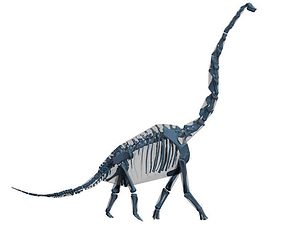A team of international scientists from Britain and the United States have devised a new mathematical formula, considered more accurate than previous methods, which measures the body weight of dinosaurs – they found that dinosaurs weighed much less than previous estimates had considered. For instance, the giant Berlin Brachiosaur, which lived in the late Jurassic period (from about 200 million to 145 million years ago), measuring about 82 feet from nose to tail, previously estimated to weigh as much as 80 tons, only weighs 23 tons according to the new model.

The scientists used lasers to measure the minimum amount of skin needed to cover the skeletons of large modern animals that included reindeer, polar bears, giraffes and elephants.
“It’s a mathematical technique that effectively wraps a skin as tightly as it can around the bones,” explained study author Bill Sellers of the University of Manchester in northwestern England.
“This gives us a ‘skin and bones’ model (from) which we can measure the volume”
One of the main methods of measuring dinosaur mass is based on artistic interpretation, in which a reconstruction sculpture of the animal is made and then dipped into the water to measure the volume. By multiplying the volume by density, results the mass.
“The problem with this is the artist’s reconstruction,” he said. “These are very time consuming to do and probably rather inaccurate, so we thought we’d try a new method.”
The researchers found that of the 14 large-framed modern mammals they laser screen, almost all of them had exactly 21 percent more body mass than the minimum skeletal “skin and bone” wrap volume.
“Mammals are only distantly related but the way they stand and move is broadly similar to four-legged dinosaurs so we think they are about as good a model as we can get,” said Sellers.
By applying the same model to the giant Brachiosaur skeleton housed at Berlin’s Museum für Naturkunde, findings suggest it would have tipped the scales at a relatively featherweight 23 tons, more than 70% less than the previous estimated 80 tones. The researchers believe that not all dinosaurs would be subjected to the same proportion of “weight loss”, but that still their mass would be significantly lighter than previous estimates.
“The 23 tonne weight (50,706 pounds) is quite low, but I think it reflects the fact that all dinosaur weights are getting lower,”
He continued that the new estimate “reflects a better understanding of biology, and I think the early estimates were set in that big, fat and slow lizard mindset before the dinosaur renaissance. I think we will find that the lower estimates are much more appropriate for many dinosaurs.”
As the first estimates were made, paleontologists lacked today’s supercomputers and instruments, so the way dinosaurs were depicted and described was very much subjective. These new findings, might forever change the way dinosaurs are depicted in school books, museums and other recreations. However, for this method to retrieve the mass of an animal, it needs a complete skeleton. The Berlin Brachiosaurus, or Giraffatitan brancai, was chosen for the study as it is one of the most complete dinosaur fossil specimens available.
Heinrich Mallison of the Museum für Naturkunde told Discovery News that the new study describes “a brilliant approach: not trying to estimate soft tissues, but finding out how much a bone-only model underestimates the entire animal’s mass.”
Mallison thinks it is “certainly a very good method for mammals, but I’d like to see tests with more details to find out if archosaurs (crocodiles and dinosaurs) have the same regressions, or differ.”






